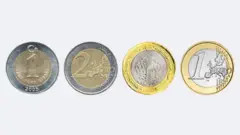Dutch Central Bank Warns Against Turkish Lira Coin Scam: Don’t Mistake 1 Lira for 2 Euros
The Dutch Central Bank (DNB) has issued a warning to consumers about the fraudulent use of the 1 Turkish Lira coin, which closely resembles the 2 Euro coin. According to the central bank, there have been increasing reports of businesses and individuals mistakenly giving 1 Turkish Lira coins as change instead of 2 Euro coins, exploiting the visual similarities between the two currencies.
The DNB stated that complaints have been filed by individuals who, after making purchases, received “a foreign currency that closely resembles the euro” as change. This “confusing foreign coin” has been identified as the 1 Turkish Lira, which bears a striking resemblance to the 2 Euro coin. The bank has even released a photograph illustrating the similarity between the two coins to highlight the potential for confusion and deception.
 Side-by-side comparison of a Euro and Turkish Lira coin highlighting the visual similarity that leads to currency confusion and potential fraud, as warned by the Dutch Central Bank.
Side-by-side comparison of a Euro and Turkish Lira coin highlighting the visual similarity that leads to currency confusion and potential fraud, as warned by the Dutch Central Bank.
The similarity lies in the coins’ comparable size and the contrasting colors of their composition. However, despite these visual parallels, the Dutch Central Bank emphasizes the significant difference in value. A 1 Turkish Lira coin is worth considerably less than a 2 Euro coin – in fact, it’s valued at less than 5 Euro cents. This stark difference in value is the core of the scam, where unsuspecting individuals are shortchanged when given Turkish Lira instead of Euros.
The bank’s statement advises, “Our recommendation is to always be careful when receiving change after paying in cash. Because if you receive 1 Lira, you only have 5 cents and not 2 euros.” This highlights the substantial financial loss one could incur by unknowingly accepting the Turkish Lira coin.
This issue of currency confusion is not new. Back in 2005, when the coin was initially introduced as the “New Turkish Lira” (YTL), numerous complaints arose across Europe. Due to its resemblance to the 2 Euro coin, the 1 Turkish Lira coin was reportedly used fraudulently in vending machines, slot machines, and other automated systems throughout Europe, being accepted as a 2 Euro equivalent.
In response to this widespread misuse, many businesses modified their vending machines and systems to reject non-Euro coins, aiming to prevent further financial losses. While the currency name was changed from “YTL” to “1 TL” in 2009, the visual similarity and potential for confusion remain. Furthermore, in the same year of the name change, the Turkish Mint reduced the weight of the 1 TL coin from 8.1 grams to 6.6 grams due to rising production costs. This weight change, however, did not address the fundamental issue of visual similarity with the 2 Euro coin and the ongoing potential for scams exploiting this likeness.
